.connections
class: ConnectionData
- class ConnectionData(**kwargs)[source]
Data point that represents a connection
fromone data point,toanother.Class Inheritance
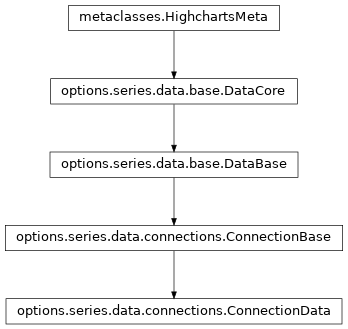
- copy(other=None, overwrite=True, **kwargs)
Copy the configuration settings from this instance to the
otherinstance.- Parameters:
other (
HighchartsMeta) – The target instance to which the properties of this instance should be copied. IfNone, will create a new instance and populate it with properties copied fromself. Defaults toNone.overwrite (
bool) – ifTrue, properties inotherthat are already set will be overwritten by their counterparts inself. Defaults toTrue.kwargs – Additional keyword arguments. Some special descendents of
HighchartsMetamay have special implementations of this method which rely on additional keyword arguments.
- Returns:
A mutated version of
otherwith new property values
- classmethod from_array(value)[source]
Generator method which produces a collection of
ConnectionDatainstances derived fromvalue. Generally consumed by the setter methods in series-type specific data classes.- Return type:
listofConnectionDatainstances
- classmethod from_dict(as_dict: dict, allow_snake_case: bool = True)
Construct an instance of the class from a
dictobject.
- classmethod from_js_literal(as_str_or_file, allow_snake_case: bool = True, _break_loop_on_failure: bool = False)
Return a Python object representation of a Highcharts JavaScript object literal.
- Parameters:
as_str_or_file (
str) – The JavaScript object literal, represented either as astror as a filename which contains the JS object literal.allow_snake_case (
bool) – IfTrue, interpretssnake_casekeys as equivalent tocamelCasekeys. Defaults toTrue._break_loop_on_failure (
bool) – IfTrue, will break any looping operations in the event of a failure. Otherwise, will attempt to repair the failure. Defaults toFalse.
- Returns:
A Python object representation of the Highcharts JavaScript object literal.
- Return type:
HighchartsMeta
- classmethod from_json(as_json_or_file, allow_snake_case: bool = True)
Construct an instance of the class from a JSON string.
- Parameters:
as_json_or_file – The JSON string for the object or the filename of a file that contains the JSON string.
allow_snake_case (
bool) – IfTrue, interpretssnake_casekeys as equivalent tocamelCasekeys. Defaults toTrue.
- Returns:
A Python objcet representation of
as_json.- Return type:
HighchartsMeta
- to_dict() dict
Generate a
dictrepresentation of the object compatible with the Highcharts JavaScript library.Note
The
dictrepresentation has a property structure and naming convention that is intentionally consistent with the Highcharts JavaScript library. This is not Pythonic, but it makes managing the interplay between the two languages much, much simpler.
- to_js_literal(filename=None, encoding='utf-8') str | None
Return the object represented as a
strcontaining the JavaScript object literal.
- to_json(filename=None, encoding='utf-8')
Generate a JSON string/byte string representation of the object compatible with the Highcharts JavaScript library.
Note
This method will either return a standard
stror abytesobject depending on the JSON serialization library you are using. For example, if your environment has orjson, the result will be abytesrepresentation of the string.- Parameters:
- Returns:
A JSON representation of the object compatible with the Highcharts library.
- Return type:
- static trim_dict(untrimmed: dict, to_json: bool = False) dict
Remove keys from
untrimmedwhose values areNoneand convert values that have.to_dict()methods.
- static trim_iterable(untrimmed, to_json=False)
Convert any
EnforcedNullTypevalues inuntrimmedto'null'.
- property accessibility: DataPointAccessibility | None
Accessibility options for a data point.
- Return type:
DataPointAccessibilityorNone
- property class_name: str | None
The additional CSS class name to apply to the data point’s graphical elements.
- property color: str | Gradient | Pattern | None
The color of the individual data point. Defaults to
None.
- property color_index: int | None
When operating in styled mode, a specific color index to use for the point, so its graphic representations are given the class name
highcharts-color-{n}. Defaults toNone.Tip
New in version Highcharts: (JS) v.11
With Highcharts (JS) v.11, using CSS variables of the form
--highcharts-color-{n}make changing the color scheme very simple.
- property custom: JavaScriptDict | None
A reserved subspace to store options and values for customized functionality.
Here you can add additional data for your own event callbacks and formatter callbacks.
- property data_labels: DataLabel | None
Individual data label for the data point.
- Return type:
DataLabelorNone
- property description: str | None
A description of the data point to add to the screen reader information about the data point.
- Return type:
- property drag_drop: DragDropOptions | None
The draggable-points module allows points to be moved around or modified in the chart.
In addition to the options mentioned under the dragDrop API structure, the module fires three (JavaScript) events:
point.dragStartpoint.dragpoint.drop
- Return type:
DragDropOptionsorNone
- property events: PointEvents | None
Event handlers for individual data points.
- Return type:
PointEventsorNone
- property id: str | None
The id of the data point. Defaults to
None.Note
This can be used (in JavaScript) after render time to get a pointer to the point object through
chart.get().
- property label_rank: int | float | Decimal | None
The rank for this point’s data label in the case of collision. Defaults to
None.Note
If two data labels are about to overlap, the data label for the point with the highest
label_rankwill be shown.- Return type:
numeric or
None
- property name: str | None
The name to display for the point in data labels, tooltips, in legends, etc. Defaults to
None.
class: FlowmapData
- class FlowmapData(**kwargs)[source]
Variant of
ConnectionDatathat also applies aweightto the connection.Class Inheritance
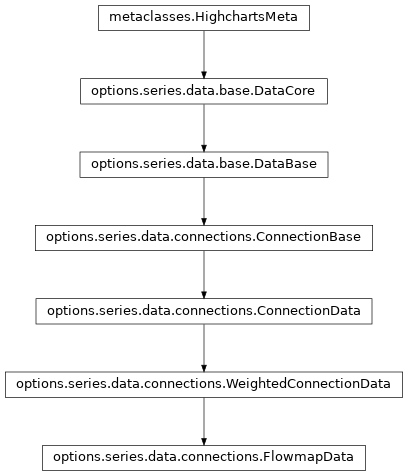
- copy(other=None, overwrite=True, **kwargs)
Copy the configuration settings from this instance to the
otherinstance.- Parameters:
other (
HighchartsMeta) – The target instance to which the properties of this instance should be copied. IfNone, will create a new instance and populate it with properties copied fromself. Defaults toNone.overwrite (
bool) – ifTrue, properties inotherthat are already set will be overwritten by their counterparts inself. Defaults toTrue.kwargs – Additional keyword arguments. Some special descendents of
HighchartsMetamay have special implementations of this method which rely on additional keyword arguments.
- Returns:
A mutated version of
otherwith new property values
- classmethod from_array(value)[source]
Generator method which produces a collection of
FlowmapDatainstances derived fromvalue. Generally consumed by the setter methods in series-type specific data classes.- Return type:
listofFlowmapDatainstances
- classmethod from_dict(as_dict: dict, allow_snake_case: bool = True)
Construct an instance of the class from a
dictobject.
- classmethod from_js_literal(as_str_or_file, allow_snake_case: bool = True, _break_loop_on_failure: bool = False)
Return a Python object representation of a Highcharts JavaScript object literal.
- Parameters:
as_str_or_file (
str) – The JavaScript object literal, represented either as astror as a filename which contains the JS object literal.allow_snake_case (
bool) – IfTrue, interpretssnake_casekeys as equivalent tocamelCasekeys. Defaults toTrue._break_loop_on_failure (
bool) – IfTrue, will break any looping operations in the event of a failure. Otherwise, will attempt to repair the failure. Defaults toFalse.
- Returns:
A Python object representation of the Highcharts JavaScript object literal.
- Return type:
HighchartsMeta
- classmethod from_json(as_json_or_file, allow_snake_case: bool = True)
Construct an instance of the class from a JSON string.
- Parameters:
as_json_or_file – The JSON string for the object or the filename of a file that contains the JSON string.
allow_snake_case (
bool) – IfTrue, interpretssnake_casekeys as equivalent tocamelCasekeys. Defaults toTrue.
- Returns:
A Python objcet representation of
as_json.- Return type:
HighchartsMeta
- to_dict() dict
Generate a
dictrepresentation of the object compatible with the Highcharts JavaScript library.Note
The
dictrepresentation has a property structure and naming convention that is intentionally consistent with the Highcharts JavaScript library. This is not Pythonic, but it makes managing the interplay between the two languages much, much simpler.
- to_js_literal(filename=None, encoding='utf-8') str | None
Return the object represented as a
strcontaining the JavaScript object literal.
- to_json(filename=None, encoding='utf-8')
Generate a JSON string/byte string representation of the object compatible with the Highcharts JavaScript library.
Note
This method will either return a standard
stror abytesobject depending on the JSON serialization library you are using. For example, if your environment has orjson, the result will be abytesrepresentation of the string.- Parameters:
- Returns:
A JSON representation of the object compatible with the Highcharts library.
- Return type:
- static trim_dict(untrimmed: dict, to_json: bool = False) dict
Remove keys from
untrimmedwhose values areNoneand convert values that have.to_dict()methods.
- static trim_iterable(untrimmed, to_json=False)
Convert any
EnforcedNullTypevalues inuntrimmedto'null'.
- property accessibility: DataPointAccessibility | None
Accessibility options for a data point.
- Return type:
DataPointAccessibilityorNone
- property class_name: str | None
The additional CSS class name to apply to the data point’s graphical elements.
- property color: str | Gradient | Pattern | None
The color of the individual data point. Defaults to
None.
- property color_index: int | None
When operating in styled mode, a specific color index to use for the point, so its graphic representations are given the class name
highcharts-color-{n}. Defaults toNone.Tip
New in version Highcharts: (JS) v.11
With Highcharts (JS) v.11, using CSS variables of the form
--highcharts-color-{n}make changing the color scheme very simple.
- property curve_factor: int | float | Decimal | None
The amount by which to curve the lines on a flowmap. Higher numbers makes the links more curved, while a value of
0makes the lines straight. Defaults toNone.- Return type:
numeric or
None
- property custom: JavaScriptDict | None
A reserved subspace to store options and values for customized functionality.
Here you can add additional data for your own event callbacks and formatter callbacks.
- property data_labels: DataLabel | None
Individual data label for the data point.
- Return type:
DataLabelorNone
- property description: str | None
A description of the data point to add to the screen reader information about the data point.
- Return type:
- property drag_drop: DragDropOptions | None
The draggable-points module allows points to be moved around or modified in the chart.
In addition to the options mentioned under the dragDrop API structure, the module fires three (JavaScript) events:
point.dragStartpoint.dragpoint.drop
- Return type:
DragDropOptionsorNone
- property events: PointEvents | None
Event handlers for individual data points.
- Return type:
PointEventsorNone
- property fill_color: str | Gradient | Pattern | EnforcedNullType | None
Fill color or gradient for the area. When
EnforcedNullType, the series’ color is used with the series’.fill_opacity.- Return type:
None,Gradient,Pattern, orEnforcedNullType
- property fill_opacity: int | float | Decimal | None
Fill opacity for the area. Defaults to
0.5.When you set an explicit
fill_color, thefill_opacityis not applied. Instead, you should define the opacity in thefill_colorwith an rgba color definition.The
fill_opacitysetting, also the default setting, overrides the alpha component of the color setting.- Return type:
numeric or
None
- property from_: str | List[int | float | Decimal] | None
The coordinates for the link’s origin point. Accepts either:
an ID referencing a map point holding coordinates of the link origin
coordinates expressed as a 2-member array of the form
[longitude, latitude],dictwith keys'lon'/'longitude'and'lat'/'latitude', orarbitrary object with
'lon'/'longitude'and'lat'/'latitude'properties.
Defaults to
None.
- property grow_towards: bool | None
If
True, the line will grow as it approaches its destination. Defaults toNone.
- property id: str | None
The id of the data point. Defaults to
None.Note
This can be used (in JavaScript) after render time to get a pointer to the point object through
chart.get().
- property label_rank: int | float | Decimal | None
The rank for this point’s data label in the case of collision. Defaults to
None.Note
If two data labels are about to overlap, the data label for the point with the highest
label_rankwill be shown.- Return type:
numeric or
None
- property line_width: int | float | Decimal | None
Pixel width of the graph line. Defaults to
None.- Return type:
numeric or
None
- property marker_end: FlowmapMarker | None
If enabled, creates an arrow symbol indicating the direction of the flow at the flow’s destination.
Warning
Setting/enabling this property in the
FlowmapOptionsobject rather than in theFlowmapSerieswill apply a marker to the end of every flowmap series in your visualization.- Return type:
FlowmapMarkeror :obj:`None <python:None>
- property name: str | None
The name to display for the point in data labels, tooltips, in legends, etc. Defaults to
None.
- property opacity: int | float | Decimal | None
Opacity for the link. Defaults to
None.- Return type:
numeric or
None
- property selected: bool | None
If
True, indicates that the data point is initially selected. Defaults toNone, which behaves asFalse.
- property to: str | List[int | float | Decimal] | None
The coordinates for the link’s destination. Accepts either:
an ID referencing a map point holding coordinates of the link origin
coordinates expressed as a 2-member array of the form
[longitude, latitude],dictwith keys'lon'/'longitude'and'lat'/'latitude', orarbitrary object with
'lon'/'longitude'and'lat'/'latitude'properties.
Defaults to
None.
class: WeightedConnectionData
- class WeightedConnectionData(**kwargs)[source]
Variant of
ConnectionDatathat also applies aweightto the connection.Class Inheritance
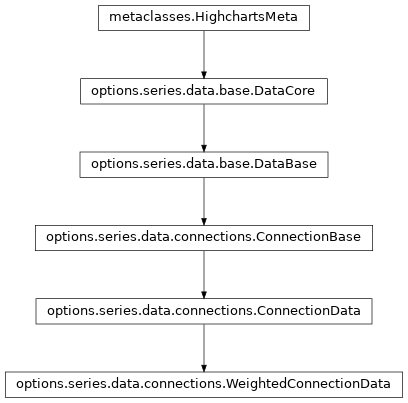
- copy(other=None, overwrite=True, **kwargs)
Copy the configuration settings from this instance to the
otherinstance.- Parameters:
other (
HighchartsMeta) – The target instance to which the properties of this instance should be copied. IfNone, will create a new instance and populate it with properties copied fromself. Defaults toNone.overwrite (
bool) – ifTrue, properties inotherthat are already set will be overwritten by their counterparts inself. Defaults toTrue.kwargs – Additional keyword arguments. Some special descendents of
HighchartsMetamay have special implementations of this method which rely on additional keyword arguments.
- Returns:
A mutated version of
otherwith new property values
- classmethod from_array(value)[source]
Generator method which produces a collection of
ConnectionDatainstances derived fromvalue. Generally consumed by the setter methods in series-type specific data classes.- Return type:
listofConnectionDatainstances
- classmethod from_dict(as_dict: dict, allow_snake_case: bool = True)
Construct an instance of the class from a
dictobject.
- classmethod from_js_literal(as_str_or_file, allow_snake_case: bool = True, _break_loop_on_failure: bool = False)
Return a Python object representation of a Highcharts JavaScript object literal.
- Parameters:
as_str_or_file (
str) – The JavaScript object literal, represented either as astror as a filename which contains the JS object literal.allow_snake_case (
bool) – IfTrue, interpretssnake_casekeys as equivalent tocamelCasekeys. Defaults toTrue._break_loop_on_failure (
bool) – IfTrue, will break any looping operations in the event of a failure. Otherwise, will attempt to repair the failure. Defaults toFalse.
- Returns:
A Python object representation of the Highcharts JavaScript object literal.
- Return type:
HighchartsMeta
- classmethod from_json(as_json_or_file, allow_snake_case: bool = True)
Construct an instance of the class from a JSON string.
- Parameters:
as_json_or_file – The JSON string for the object or the filename of a file that contains the JSON string.
allow_snake_case (
bool) – IfTrue, interpretssnake_casekeys as equivalent tocamelCasekeys. Defaults toTrue.
- Returns:
A Python objcet representation of
as_json.- Return type:
HighchartsMeta
- to_dict() dict
Generate a
dictrepresentation of the object compatible with the Highcharts JavaScript library.Note
The
dictrepresentation has a property structure and naming convention that is intentionally consistent with the Highcharts JavaScript library. This is not Pythonic, but it makes managing the interplay between the two languages much, much simpler.
- to_js_literal(filename=None, encoding='utf-8') str | None
Return the object represented as a
strcontaining the JavaScript object literal.
- to_json(filename=None, encoding='utf-8')
Generate a JSON string/byte string representation of the object compatible with the Highcharts JavaScript library.
Note
This method will either return a standard
stror abytesobject depending on the JSON serialization library you are using. For example, if your environment has orjson, the result will be abytesrepresentation of the string.- Parameters:
- Returns:
A JSON representation of the object compatible with the Highcharts library.
- Return type:
- static trim_dict(untrimmed: dict, to_json: bool = False) dict
Remove keys from
untrimmedwhose values areNoneand convert values that have.to_dict()methods.
- static trim_iterable(untrimmed, to_json=False)
Convert any
EnforcedNullTypevalues inuntrimmedto'null'.
- property accessibility: DataPointAccessibility | None
Accessibility options for a data point.
- Return type:
DataPointAccessibilityorNone
- property class_name: str | None
The additional CSS class name to apply to the data point’s graphical elements.
- property color: str | Gradient | Pattern | None
The color of the individual data point. Defaults to
None.
- property color_index: int | None
When operating in styled mode, a specific color index to use for the point, so its graphic representations are given the class name
highcharts-color-{n}. Defaults toNone.Tip
New in version Highcharts: (JS) v.11
With Highcharts (JS) v.11, using CSS variables of the form
--highcharts-color-{n}make changing the color scheme very simple.
- property custom: JavaScriptDict | None
A reserved subspace to store options and values for customized functionality.
Here you can add additional data for your own event callbacks and formatter callbacks.
- property data_labels: DataLabel | None
Individual data label for the data point.
- Return type:
DataLabelorNone
- property description: str | None
A description of the data point to add to the screen reader information about the data point.
- Return type:
- property drag_drop: DragDropOptions | None
The draggable-points module allows points to be moved around or modified in the chart.
In addition to the options mentioned under the dragDrop API structure, the module fires three (JavaScript) events:
point.dragStartpoint.dragpoint.drop
- Return type:
DragDropOptionsorNone
- property events: PointEvents | None
Event handlers for individual data points.
- Return type:
PointEventsorNone
- property id: str | None
The id of the data point. Defaults to
None.Note
This can be used (in JavaScript) after render time to get a pointer to the point object through
chart.get().
- property label_rank: int | float | Decimal | None
The rank for this point’s data label in the case of collision. Defaults to
None.Note
If two data labels are about to overlap, the data label for the point with the highest
label_rankwill be shown.- Return type:
numeric or
None
- property name: str | None
The name to display for the point in data labels, tooltips, in legends, etc. Defaults to
None.
class: OutgoingWeightedConnectionData
- class OutgoingWeightedConnectionData(**kwargs)[source]
Variant of
WeightedConnectionDatathat supports theoutogingflag.Class Inheritance
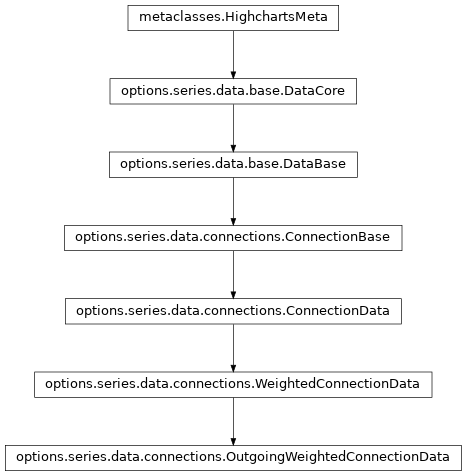
- copy(other=None, overwrite=True, **kwargs)
Copy the configuration settings from this instance to the
otherinstance.- Parameters:
other (
HighchartsMeta) – The target instance to which the properties of this instance should be copied. IfNone, will create a new instance and populate it with properties copied fromself. Defaults toNone.overwrite (
bool) – ifTrue, properties inotherthat are already set will be overwritten by their counterparts inself. Defaults toTrue.kwargs – Additional keyword arguments. Some special descendents of
HighchartsMetamay have special implementations of this method which rely on additional keyword arguments.
- Returns:
A mutated version of
otherwith new property values
- classmethod from_array(value)[source]
Generator method which produces a collection of
OutgoingWeightedConnectionDatainstances derived fromvalue. Generally consumed by the setter methods in series-type specific data classes.- Return type:
listofOutgoingWeightedConnectionDatainstances
- classmethod from_dict(as_dict: dict, allow_snake_case: bool = True)
Construct an instance of the class from a
dictobject.
- classmethod from_js_literal(as_str_or_file, allow_snake_case: bool = True, _break_loop_on_failure: bool = False)
Return a Python object representation of a Highcharts JavaScript object literal.
- Parameters:
as_str_or_file (
str) – The JavaScript object literal, represented either as astror as a filename which contains the JS object literal.allow_snake_case (
bool) – IfTrue, interpretssnake_casekeys as equivalent tocamelCasekeys. Defaults toTrue._break_loop_on_failure (
bool) – IfTrue, will break any looping operations in the event of a failure. Otherwise, will attempt to repair the failure. Defaults toFalse.
- Returns:
A Python object representation of the Highcharts JavaScript object literal.
- Return type:
HighchartsMeta
- classmethod from_json(as_json_or_file, allow_snake_case: bool = True)
Construct an instance of the class from a JSON string.
- Parameters:
as_json_or_file – The JSON string for the object or the filename of a file that contains the JSON string.
allow_snake_case (
bool) – IfTrue, interpretssnake_casekeys as equivalent tocamelCasekeys. Defaults toTrue.
- Returns:
A Python objcet representation of
as_json.- Return type:
HighchartsMeta
- to_dict() dict
Generate a
dictrepresentation of the object compatible with the Highcharts JavaScript library.Note
The
dictrepresentation has a property structure and naming convention that is intentionally consistent with the Highcharts JavaScript library. This is not Pythonic, but it makes managing the interplay between the two languages much, much simpler.
- to_js_literal(filename=None, encoding='utf-8') str | None
Return the object represented as a
strcontaining the JavaScript object literal.
- to_json(filename=None, encoding='utf-8')
Generate a JSON string/byte string representation of the object compatible with the Highcharts JavaScript library.
Note
This method will either return a standard
stror abytesobject depending on the JSON serialization library you are using. For example, if your environment has orjson, the result will be abytesrepresentation of the string.- Parameters:
- Returns:
A JSON representation of the object compatible with the Highcharts library.
- Return type:
- static trim_dict(untrimmed: dict, to_json: bool = False) dict
Remove keys from
untrimmedwhose values areNoneand convert values that have.to_dict()methods.
- static trim_iterable(untrimmed, to_json=False)
Convert any
EnforcedNullTypevalues inuntrimmedto'null'.
- property accessibility: DataPointAccessibility | None
Accessibility options for a data point.
- Return type:
DataPointAccessibilityorNone
- property class_name: str | None
The additional CSS class name to apply to the data point’s graphical elements.
- property color: str | Gradient | Pattern | None
The color of the individual data point. Defaults to
None.
- property color_index: int | None
When operating in styled mode, a specific color index to use for the point, so its graphic representations are given the class name
highcharts-color-{n}. Defaults toNone.Tip
New in version Highcharts: (JS) v.11
With Highcharts (JS) v.11, using CSS variables of the form
--highcharts-color-{n}make changing the color scheme very simple.
- property custom: JavaScriptDict | None
A reserved subspace to store options and values for customized functionality.
Here you can add additional data for your own event callbacks and formatter callbacks.
- property data_labels: DataLabel | None
Individual data label for the data point.
- Return type:
DataLabelorNone
- property description: str | None
A description of the data point to add to the screen reader information about the data point.
- Return type:
- property drag_drop: DragDropOptions | None
The draggable-points module allows points to be moved around or modified in the chart.
In addition to the options mentioned under the dragDrop API structure, the module fires three (JavaScript) events:
point.dragStartpoint.dragpoint.drop
- Return type:
DragDropOptionsorNone
- property events: PointEvents | None
Event handlers for individual data points.
- Return type:
PointEventsorNone
- property id: str | None
The id of the data point. Defaults to
None.Note
This can be used (in JavaScript) after render time to get a pointer to the point object through
chart.get().
- property label_rank: int | float | Decimal | None
The rank for this point’s data label in the case of collision. Defaults to
None.Note
If two data labels are about to overlap, the data label for the point with the highest
label_rankwill be shown.- Return type:
numeric or
None
- property name: str | None
The name to display for the point in data labels, tooltips, in legends, etc. Defaults to
None.
- property outgoing: bool | None
If
True, indicates that the data point links out of the system. Defaults toNone, which behaves asFalse.
class: ConnectionBase
- class ConnectionBase(**kwargs)[source]
Data point that represents a connection
fromone data point,toanother.Class Inheritance
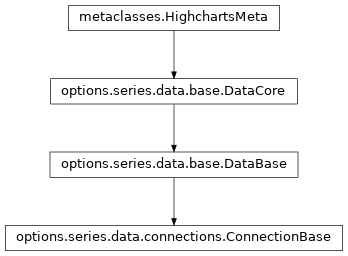
- copy(other=None, overwrite=True, **kwargs)
Copy the configuration settings from this instance to the
otherinstance.- Parameters:
other (
HighchartsMeta) – The target instance to which the properties of this instance should be copied. IfNone, will create a new instance and populate it with properties copied fromself. Defaults toNone.overwrite (
bool) – ifTrue, properties inotherthat are already set will be overwritten by their counterparts inself. Defaults toTrue.kwargs – Additional keyword arguments. Some special descendents of
HighchartsMetamay have special implementations of this method which rely on additional keyword arguments.
- Returns:
A mutated version of
otherwith new property values
- classmethod from_array(value)[source]
Creates a collection of data point instances, parsing the contents of
valueas an array (iterable). This method is specifically used to parse data that is input to Highcharts for Python without property names, in an array-organized structure as described in the Highcharts JS documentation.See also
The specific structure of the expected array is highly dependent on the type of data point that the series needs, which itself is dependent on the series type itself.
Please review the detailed series documentation for series type-specific details of relevant array structures.
Note
An example of how this works for a simple
LineSeries(which usesCartesianDatadata points) would be:my_series = LineSeries() # A simple array of numerical values which correspond to the Y value of the # data point my_series.data = [0, 5, 3, 5] # An array containing 2-member arrays (corresponding to the X and Y values # of the data point) my_series.data = [ [0, 0], [1, 5], [2, 3], [3, 5] ] # An array of dict with named values my_series.data = [ { 'x': 0, 'y': 0, 'name': 'Point1', 'color': '#00FF00' }, { 'x': 1, 'y': 5, 'name': 'Point2', 'color': '#CCC' }, { 'x': 2, 'y': 3, 'name': 'Point3', 'color': '#999' }, { 'x': 3, 'y': 5, 'name': 'Point4', 'color': '#000' } ]
- Parameters:
value (iterable) –
The value that should contain the data which will be converted into data point instances.
Note
If
valueis not an iterable, it will be converted into an iterable to be further de-serialized correctly.- Returns:
Collection of data point instances (descended from
DataBase)- Return type:
- classmethod from_dict(as_dict: dict, allow_snake_case: bool = True)
Construct an instance of the class from a
dictobject.
- classmethod from_js_literal(as_str_or_file, allow_snake_case: bool = True, _break_loop_on_failure: bool = False)
Return a Python object representation of a Highcharts JavaScript object literal.
- Parameters:
as_str_or_file (
str) – The JavaScript object literal, represented either as astror as a filename which contains the JS object literal.allow_snake_case (
bool) – IfTrue, interpretssnake_casekeys as equivalent tocamelCasekeys. Defaults toTrue._break_loop_on_failure (
bool) – IfTrue, will break any looping operations in the event of a failure. Otherwise, will attempt to repair the failure. Defaults toFalse.
- Returns:
A Python object representation of the Highcharts JavaScript object literal.
- Return type:
HighchartsMeta
- classmethod from_json(as_json_or_file, allow_snake_case: bool = True)
Construct an instance of the class from a JSON string.
- Parameters:
as_json_or_file – The JSON string for the object or the filename of a file that contains the JSON string.
allow_snake_case (
bool) – IfTrue, interpretssnake_casekeys as equivalent tocamelCasekeys. Defaults toTrue.
- Returns:
A Python objcet representation of
as_json.- Return type:
HighchartsMeta
- to_dict() dict
Generate a
dictrepresentation of the object compatible with the Highcharts JavaScript library.Note
The
dictrepresentation has a property structure and naming convention that is intentionally consistent with the Highcharts JavaScript library. This is not Pythonic, but it makes managing the interplay between the two languages much, much simpler.
- to_js_literal(filename=None, encoding='utf-8') str | None
Return the object represented as a
strcontaining the JavaScript object literal.
- to_json(filename=None, encoding='utf-8')
Generate a JSON string/byte string representation of the object compatible with the Highcharts JavaScript library.
Note
This method will either return a standard
stror abytesobject depending on the JSON serialization library you are using. For example, if your environment has orjson, the result will be abytesrepresentation of the string.- Parameters:
- Returns:
A JSON representation of the object compatible with the Highcharts library.
- Return type:
- static trim_dict(untrimmed: dict, to_json: bool = False) dict
Remove keys from
untrimmedwhose values areNoneand convert values that have.to_dict()methods.
- static trim_iterable(untrimmed, to_json=False)
Convert any
EnforcedNullTypevalues inuntrimmedto'null'.
- property accessibility: DataPointAccessibility | None
Accessibility options for a data point.
- Return type:
DataPointAccessibilityorNone
- property class_name: str | None
The additional CSS class name to apply to the data point’s graphical elements.
- property color: str | Gradient | Pattern | None
The color of the individual data point. Defaults to
None.
- property color_index: int | None
When operating in styled mode, a specific color index to use for the point, so its graphic representations are given the class name
highcharts-color-{n}. Defaults toNone.Tip
New in version Highcharts: (JS) v.11
With Highcharts (JS) v.11, using CSS variables of the form
--highcharts-color-{n}make changing the color scheme very simple.
- property custom: JavaScriptDict | None
A reserved subspace to store options and values for customized functionality.
Here you can add additional data for your own event callbacks and formatter callbacks.
- property description: str | None
A description of the data point to add to the screen reader information about the data point.
- Return type:
- property events: PointEvents | None
Event handlers for individual data points.
- Return type:
PointEventsorNone
- property id: str | None
The id of the data point. Defaults to
None.Note
This can be used (in JavaScript) after render time to get a pointer to the point object through
chart.get().
- property label_rank: int | float | Decimal | None
The rank for this point’s data label in the case of collision. Defaults to
None.Note
If two data labels are about to overlap, the data label for the point with the highest
label_rankwill be shown.- Return type:
numeric or
None
- property name: str | None
The name to display for the point in data labels, tooltips, in legends, etc. Defaults to
None.